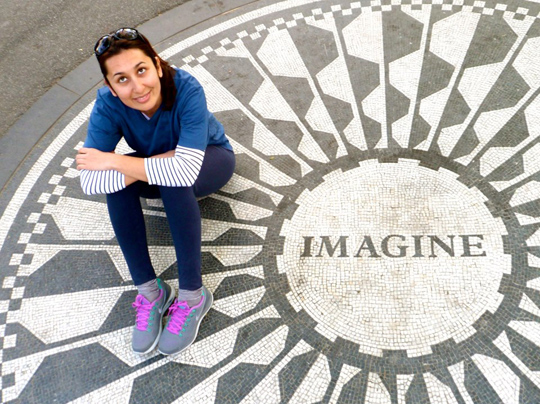The sunset in Manhattan this evening was an exquisite show of lights and colors, mirrored in the skyscrapers’ glass. Pink and baby-blue rapidly become orange and after a few more blinks the whole sky is dark blue. The towers on Central Park South and all around Columbus Circle start to lighten up in a perfectly synchronized rhythm – giving Manhattan a special glow that appears on postcards and in movies. New York’s glamour and continuous change attract people from all over the world who want to rediscover themselves and hence question their inherited identity.
When I first visited New York, a few years ago, I was just starting to explore my long-denied Roma/Gypsy ethnic identity. As I experienced the cosmopolitan life and became aware of the city’s global vibe, a question kept occurring to me: what does it mean to be Roma?
But first I should say that many people, especially here in the United States, don’t know who the Roma are. They know something about Gypsies – but often they think that Gypsies are these magic characters from fairy tales who tell fortunes and dress in colorful costumes…you know, like on Halloween. They are surprised to hear that there are about one million Roma living in the United States, that the number of Roma in the world – about 12 million – is approximately the same as the Jewish population, and that these cultures share many historical similarities, including the same fate during Holocaust.
In Europe, by contrast, most people know all too well “who the Gypsies are” – those poor and uneducated people who live at the margin of their village or in a ghetto in their city. They are inferior and unworthy. Gypsies are the neighbors they don’t want to have, the classmate they try to avoid. All across Europe, they’re a shame to the countries where they reside because they steal, beg and refuse to settle down. Gypsies, in some Europeans’ opinion, should go back to India, where they originally came from, despite the fact that their history has been intertwined with Europe’s for more than seven hundred years.
At the political level, however, both in Europe and the United States, the Roma are an ethnic minority that has suffered from many forms of injustice, discrimination and even slavery, and social stigma. The overall conversation on the Roma – including most projects, advocacy and initiatives – is focused on social issues: fighting racism and stopping human rights violations. Many NGO’s that work with/for Roma focus on poverty – they try to help Roma obtain a better standard of living.
All of these ways of presenting Roma are a window onto the Roma’s current plight and vulnerable social condition, but, even after exploring all these layers, I still had not reached satisfactory answers to my dilemmas about the Roma/Gypsy identity.
It is true that these issues have greatly affected the Roma and their sense of identity, but these characteristics should not form our sense of identity – individually or as a culture.
The worst thing that we can do, as an individual or culture, is to transform problems into our identity. Seeking pride, status and values in our cultures and social groups is a fundamental human need. But the characteristics that dominate the Roma/Gypsy narrative are not the stuff of which a positive and empowering self-image is likely to be made. It is the fear of being labeled the lowest of the low, regardless of one’s talents and qualities, that keeps many Roma invisible, as I myself was until not too long ago. True, some Roma find a sense of pride in traditional lives – wearing traditional costumes, singing Gypsy music and respecting old traditions. But this is not the lifestyle I and many other Roma choose to lead.
Although poverty, exclusion, and even a traditional way of life, are associated with the Roma, none of them are unique to Roma/Gypsies. These are characteristic of other patriarchal societies and marginalized groups. Look at rural India or Pakistan and one will find similar traditions and rules. Observe the dynamics within other marginalized groups, whether African-Americans or gay people, and one will discover similar patterns.
Then what does it mean to be Roma/Gypsy and what is unique to our culture? What can it mean for those like me who live a modern life and are part of the broader world, while at the same time valuing their ethnicity and seeking meaning in their cultural heritage? What can it mean to be Roma – not 700 hundred years ago when we entered Europe, not decades ago during Holocaust, but now, at the beginning of 21st century?
The emerging global world is becoming less about borders and more about freedom and mobility. Life in the global world is less about being rooted in a particular territory and more about being in between cultures. But Gypsies have always been a “people without borders,” lacking their own territory or nation. As a professor of mine said: “History has caught up with Gypsies.” And now it is our turn to catch up to modernity by redefining ourselves and transforming our social condition.
New York, and more broadly the multicultural United States, has helped me redefine my own identity and see my cultural heritage with new eyes – breaking off the struggles of the past, looking beyond what is and imagining what the Roma identity could become. I can finally resolve my confusion and say that, for me…being Roma/Gypsy means being global. In a similar way, the Roma/Gypsy culture has a remarkable, historic opportunity to redefine its identity and core values in a more welcoming global context.
See original aat:
http://www.areteyouth.org/blog/entry/roma_gypsy_means_being_global/






